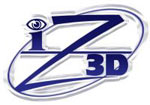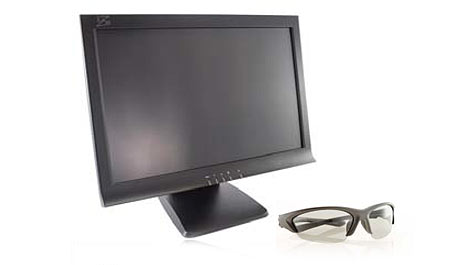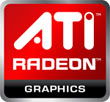Build Your Own: Wall-Sized 3D Gaming, Just Like Theaters Do It
Software: 3D Drivers For Games And Movies
Now that we've covered the mechanical basics of the most common commercially-available 3D displays, let's shift the focus back to the PC. This is a Tom's Hardware article after all.
As it stands, there are three drivers you can use to experience 3D games and content on the PC: Nvidia's GeForce 3D Vision driver, iZ3D's 3D display driver, and DDD's TriDef Experience package. All three of these products do very similar things, yet they approach the market from vastly different angles.
Nvidia GeForce 3D Vision
Let's start with Nvidia's o3D Vision driver. Nvidia is the only 3D driver supplier that also manufactures graphics cards and LCD shutter glasses for 3D stereoscopic use. Not surprisingly, Nvidia's driver is proprietary and only works with GeForce hardware. This is, of course, a plus for GeForce card owners, especially since the 3D driver is free if you own one of Nvidia’s cards. Because these drivers are made specifically by the GPU vendor, it arguably has the best hooks into the hardware, and since Nvidia has such a long history of game support, we expect games to run as well as could be expected when a 3D stereoscopic output is selected. Finally, Nvidia has a head start when it comes to 3D Blu-ray compatibility on the PC, as it has partnered with both TV and software manufacturers. Both CyberLink and ArcSoft have indicated that their 3D Blu-ray playback software will work with Nvidia's 3D Vision glasses.
What's the downside of Nvidia's 3D Vision software? The main drawback is that the driver only supports Nvidia's GeForce hardware and cannot be used with AMD’s Radeon graphics cards, an understandable limitation given the circumstance. The second limitation, and the one that pains us in this particular review, is that the 3D Vision driver does not work with a dual-projector setup.
We are setting up a follow-up review in which we will put 3D Vision to the test using a 3D Vision-compatible projector. But for the purposes of this particular article, we will have to turn to the other two 3D driver producers for a dual-projector solution.
iZ3D's Stereoscopic Driver
Get Tom's Hardware's best news and in-depth reviews, straight to your inbox.
Next, let's consider the iZ3D driver. This company also sells hardware, but it makes 3D monitors and not graphics cards. iZ3D produces a line of 3D monitors that utilize polarized filters to deliver a separate image to each eye and polarized glasses are required to view the effect.
Selling a 3D monitor is difficult if it can't do anything in 3D, so iZ3D created its own game driver to run on iZ3D stereoscopic 3D monitors. This driver is graphics hardware-agnostic, meaning that it will work with both GeForce and Radeon cards. The driver is targeted at gaming duty, but iZ3D will release an application programming interface (API) in the near future that should allow developers to work with the driver. Potentially, this would allow 3D Blu-ray software players to access the iZ3D driver for movie playback, although no company has specifically announced an intention to do so yet.
However, the iZ3D driver doesn't require an iZ3D monitor. In fact, it works on a wide array of 3D display types, including a dual-projection mode for polarized displays. This makes it an ideal candidate for our theater-style 3D project, so we'll put the iZ3D driver through the paces during our testing. The driver costs $49.99 for a single-computer license.
One limitation we should mention is that the iZ3D driver only works with DirectX 9 and OpenGL titles, while DirectX 10 and 11 are not yet supported. This isn't nearly as bad as it sounds, as modern games, including Crysis, still have a DirectX 9 path. This DirectX 9 limitation is shared by the DDD TriDef driver that we introduce below.
On a side note, iZ3D and AMD have formed a partnership, and iZ3D offers its driver free to AMD customers who wish to use it for checkerboard and stereoscopic 3D output from a DLP rear-projection television.
Digital Dynamic Depth's TriDef 3D Stereoscopic Driver
Digital Dynamic Depth (DDD) is a company unlike both Nvidia and iZ3D in that it produces no hardware. This firm provides software solutions for a very wide variety of projects including Hyundai's P240W 3D monitor, 2D-to-3D movie conversions for the film industry, custom 3D solutions for unique products like Samsung's 3D phone, and the TriDef 3D experience suite of game, movie, and photo software for the PC.
Like the iZ3D driver, the TriDef driver doesn't require specific graphics hardware, so it will work on either Radeon or GeForce cards. The TriDef driver also works on multiple 3D-display types including alternate-frame-sequential and dual-projector systems. The TriDef 3D Experience software suite costs $49.99, but it includes a lot more than just a game driver. It does share the same DirectX 9 gaming limitation as its iZ3D counterpart, though.
DDD's solution is unique in that it not only provides a 3D game driver (called TriDef Ignition), but it also comes with the TriDef media player and TriDef photo transformer. The TriDef media player is surprisingly able to playback standard 2D video files and DVDs and convert them into 3D output in real-time. Using an algorithm that analyzes the color, position, and movement of objects in the scene, the TriDef media player delivers a 3D approximation of the video. The result works surprisingly well (more on that later). This same technology is used to convert photos in the TriDef photo-transformer software. We should mention that the upcoming CyberLink PowerDVD 10 has been announced to support a similar 2D-to-3D conversion for video files and DVDs.
Like its competitors, DDD has strategic relationships with other companies, most notably Samsung. There is a 3D starter pack that you can purchase for $150 that includes the TriDef 3D Experience software, two pairs of LCD shutter glasses, and a transmitter that is compatible with Samsung's older 3D-ready plasma and DLP TVs.
While the folks at DDD mentioned that the company is currently investigating 3D Blu-ray playback and there are no concrete announcements, we certainly hope it is able to offer a viable alternative to the market when the time comes.
AMD's Open Stereo 3D Initiative
While AMD doesn't make a 3D stereo driver, it has a hand in the industry and is working to offer a competitive alternative to Nvidia's 3D Vision technology that can work with Radeon graphics cards.
Recently, at the Game Developers Conference in March, AMD announced an Open Stereo 3D initiative and plans to update its Direct3D driver in order to enable third-party middleware vendors like iZ3D, DDD, CyberLink, and ArcSoft to output alternate-frame sequencing at 120 Hz for LCD shutter glasses. It also mentioned plans to support DirectX 9 through DirectX 11 and Blu-ray 3D movies. With the imminent introduction of 3D Blu-ray in the near future, AMD is motivated to come up with a competitive solution, and a company spokesman claimed that by the time 3D Blu-ray hits the shelves, AMD will be ready. Of course, the ecosystem has been a long time in the making for companies like Nvidia, so we're curious to see how AMD plans to catch up.
Current page: Software: 3D Drivers For Games And Movies
Prev Page Dual-Projector Polarization Next Page Hardware: Dual-Projector 3D Theater ChecklistDon Woligroski was a former senior hardware editor for Tom's Hardware. He has covered a wide range of PC hardware topics, including CPUs, GPUs, system building, and emerging technologies.
-
Don't gives too big an image to try and see it 3d. A monitor can't handle: 800px \00d7 248px!!!! That's just crazy big!!!Reply
-
Icehearted As for poor folk like me, we'll just settle for those still images where we cross our eyes, and cry because $2,565 is far away from "comfortable".Reply -
tigerwraith 2.6k now but you know things like this keep getting cheaper and cheaper. Maybe by this time next year, the 1080p 2600 lumens will drop to 500, and the drivers will better support dual projector setups.Reply -
gti88 Great article! Thanx a lot.Reply
But as I can see, 3D stereo is not there yet.
Almost no movies are available at 3DS, and game developers don't focus on stereo optimisation. Thus, we have some glitches and inconveniences. -
pojih ahh, something else to cost an arm and a leg...Reply
not saying that many people here don't want the fastest and most expensive....
but it was clearly shown that many people looking at this site want something that performs for what it costs, as seen by the fermi release and the comments ..... -
skora Whats the next price bracket up for a projector with higher res?Reply
I like the idea of dual projectors better than the alt-image standard, but they didn't ask me.
Here's a wild thought, soon, everyone will have their own glasses that not only do the shutter for 3D, but will also be able to be personal monitors. Connect to any computer/phone/TV with your glasses. Displays might even become unnecessary. That will be the next wireless mainstream device. The iShades. Phone, mobile pc and display, earbud is right there. Have pants that have built in keyboard. We'll all just be sitting there with our shades on and never see the person next to us as we get lost in the cloud. And it all starts with 3D glasses. :P -
djab IceheartedAs for poor folk like me, we'll just settle for those still images where we cross our eyes, and cry because $2,565 is far away from "comfortable".Reply
No, you can at least use red/cyan paper glasses with iz3d drivers and a normal display.
That is not that bad!




